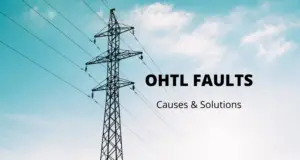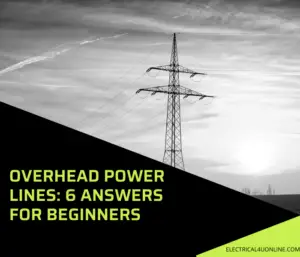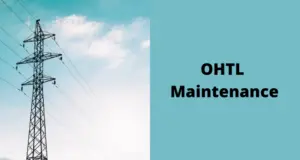Table of Contents
What are overhead power lines
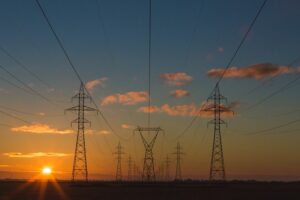
Overhead power lines are electrical transmission and distribution lines that are installed above the ground on poles or towers. They are a common method for transporting electrical energy from power plants to substations and from substations to homes, businesses, and industries.
These lines consist of conductors made of aluminum or copper that carry high-voltage electricity from the source to the end users.
Overhead power lines are a vital component of the electrical grid infrastructure, enabling the efficient and widespread distribution of electricity across various regions. They are typically used for long-distance power transmission and can cover vast distances, making them a cost-effective solution for delivering electricity to remote or densely populated areas.
Despite their importance in delivering electricity, overhead power lines can pose certain challenges, including the risk of damage from extreme weather conditions, such as storms, high winds, and lightning strikes. Additionally, they can be susceptible to disruptions from falling trees, animals, or human-made obstructions.
To minimize these risks, some overhead power lines are equipped with protective insulators, lightning arrestors, and other safety features.
The construction is very simple. depending upon the phase system, It consists of multiple not insulated conductors suspended by poles or towers.
Classification of overhead power lines
Overhead transmission lines are categorized based on their design, voltage levels, and application. Some of the common types of overhead transmission lines include:
-
Primary Distribution Lines: These lines typically operate at medium voltages and are responsible for distributing power from substations to residential and commercial areas.
-
Sub-Transmission Lines: Sub-transmission lines carry power at higher voltages than primary distribution lines, typically ranging from 33 kV to 132 kV. They are used to transmit power from local substations to distribution substations.
-
High-Voltage Transmission Lines: These lines operate at even higher voltage levels, ranging from 132 kV to 765 kV, and are used for long-distance power transmission, often spanning across states or regions.
-
Extra-High-Voltage (EHV) Transmission Lines: EHV transmission lines operate at voltage levels above 345 kV. They are used for transmitting large amounts of power over very long distances, often connecting major power plants to regional or national grids.
-
Ultra-High-Voltage (UHV) Transmission Lines: UHV transmission lines operate at extremely high voltage levels, typically exceeding 800 kV. These lines are designed for long-distance transmission of large quantities of electricity, often across international borders.
-
AC (Alternating Current) Transmission Lines: AC transmission lines are the most common type of overhead transmission lines, used for the transmission of alternating current from power plants to distribution networks and end users.
-
HVDC (High Voltage Direct Current) Transmission Lines: HVDC transmission lines transmit electricity in the form of direct current, offering lower energy losses over long distances compared to AC transmission lines. They are used for interconnecting power systems, often across large bodies of water or between regions with varying grid frequencies.
Each type of overhead transmission line serves a specific purpose within the electrical grid infrastructure, enabling the efficient and reliable transmission of electricity from power generation sources to end users over varying distances.
Structure of overhead transmission line
In different regions of the world, different structures of overhead transmission lines are in use. The simple structure consists of a wooden pole having more than one arm. The arms are used for hanging the wires.
Other structures that are common in use are tabular steel poles and concrete poles.
The wooden structure has three cross arms that are extended on one or different sides. The lattice tower consists of two forms.
The first one is a pyramidal structure having cross arms extended outside, the second one is a pyramidal base having four support points extended outside.
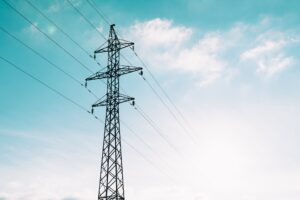
overhead line maintenance and Inspection
OHTL contains 3 important components, Insulators, towers, and conductors.
Making regular electrical inspections for the OHTL network makes a difference in faults and power reliability.
Hereunder are some inspections for overhead transmission lines.
I have written a detailed article about OHTL maintenance, you can find it here for more information.
Insulator maintenance
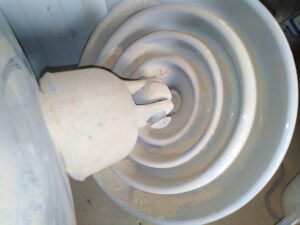
Insulators get dirty due to environmental pollution and dusty weather. Visual inspection could be done without power isolation because you could inspect them from a safe distance.
Cleaning insulators is one of the most important preventive maintenance.
As you know dirty insulators may pass electrical current as a flash-over. This flash-over can destroy the insulator as well as cause an earth leakage fault.
The cleaning insulators process takes two forms. One is by direct contact with it and using a piece of dry and smooth clothing, in this case, power must be isolated.
The second way is to clean with a water jet without power isolation. Only well-trained persons can do this dangerous job with special precautions.
Sometimes the insulators get broken for many reasons. In this case, the broken one should be replaced.
Insulator replacement could be done without power isolation but, with great precautions and special isolated tools. The company I work for hires third-party specialists to do hot washing and live maintenance for OHTL.
Conductor inspection and maintenance
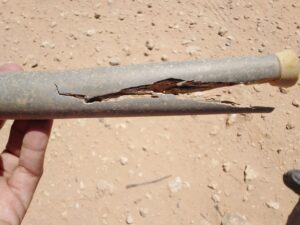
Due to aging and windy weather besides short circuits and lightning strikes the overhead power line conductors are cut.
In this case, the damaged conductor could be replaced or repaired with proper connecting devices.
This image was taken by me, in my workplace we used this splicing device to connect a cut OHTL wire, and we found the splice itself broken during visual inspection.
Towers or poles inspection
Poles and towers are less affected by faults and weather. But with age, it may get corroded. This is most likely to happen in a high-humidity environment. Visual inspection can help detect any corrosion in its early stages.
Regularly inspect the transmission line towers for signs of structural damage, such as cracks, deformations, or foundation issues, and perform necessary repairs or reinforcements to ensure the stability and safety of the entire structure.
Here are some key maintenance and inspection practices for OHTL:
-
Visual Inspections: Regularly conduct visual inspections of the entire transmission line, including the conductors, insulators, towers, and hardware, to identify any signs of wear, damage, or corrosion.
-
Vegetation Management: Clear any vegetation or trees that pose a risk of interfering with the transmission lines, as they can cause power outages or damage to the lines during storms or high winds.
-
Conductor Cleaning: Periodically clean the transmission line conductors to remove any contaminants or debris that may affect the performance and efficiency of the lines.
-
Hardware Inspection and Replacement: Inspect and replace any damaged or worn hardware components, such as insulators, fittings, and connectors, to maintain the structural integrity and electrical performance of the transmission line.
-
Corrosion Protection: Implement corrosion protection measures for metallic components of the transmission line to prevent rusting and degradation over time, especially in regions with high humidity or exposure to corrosive environments.
-
Line Tensioning: Monitor and adjust the tension of the conductors to maintain the proper sag and tension levels, ensuring the mechanical and electrical integrity of the transmission line.
-
Thermal Imaging Inspections: Conduct periodic thermal imaging inspections to identify any hotspots or potential issues related to excess heat generation, which could indicate faulty components or connections.
-
Weather-related Inspections: Perform inspections after severe weather events, such as storms or heavy snow, to assess any potential damage or impacts on the transmission lines and towers.
-
Regular Testing and Maintenance of Protective Devices: Test and maintain protective devices, such as lightning arresters and surge arresters, to ensure they are functioning correctly and providing effective protection against transient overvoltages.
By following these maintenance and inspection practices, operators can ensure the reliability, safety, and optimal performance of overhead transmission lines, minimizing the risk of power outages and maintaining the integrity of the electrical grid. Regular maintenance helps extend the lifespan of the equipment and reduces the likelihood of unexpected failures or accidents.
transmission line inspection checklist
Certainly, here’s an example of a simple table for a transmission line inspection checklist:
| Component | Inspection Criteria | Condition | Action Needed |
|---|---|---|---|
| Towers and Poles | Structural integrity | Good / Fair / Poor | Repair / Replace |
| Conductors | Wear, corrosion, foreign objects | Good / Fair / Poor | Clean / Replace |
| Insulators and Hardware | Cracks, tracking, wear, proper installation | Good / Fair / Poor | Repair / Replace |
| Grounding System | Integrity of connections | Satisfactory / Unsatisfactory | Rework / Replace |
| Vegetation Management | Clearance from the transmission line | Acceptable / Unacceptable | Trim / Remove |
| Tower Foundation | Erosion, settling, structural issues | None / Minor / Major | Repair / Reinforce |
| Clearance and Right-of-Way | Adequate clearance and free of encroachments | Clear / Not Clear | Clear / Notify Authorities |
| Environmental Factors | Impact of weather, temperature, humidity | Normal / Abnormal | Monitor / Mitigate |
| Safety Equipment | Functionality of safety devices | Functional / Non-functional | Repair / Replace |
| Documentation | Record keeping of inspection dates and findings | Updated / Incomplete | Document / Complete |
You can customize this table further based on the specific criteria and requirements of your transmission line inspection checklist.
OTHL vs underground cables
Electrical power transmission is done through OHTL or underground cables. The difference between them is listed below.
|
|
OHTL | Underground cables |
| Cost | LOW | HIGH |
| Safety | Less safe | Safer |
| Fault detection | Easy | difficult |
| Not suitable in cities | suitable in cities |
Install my Free Android App on Google Play:
Electrical Cables Most Common Tables
And, my Electrical Calculations App “”
Discover more great content by subscribing to My channel
Looking to stay ahead of the game in the world of electrical engineering? Subscribe to my YouTube channel and gain access to exclusive content you won’t find anywhere else!
The staff I recommend
(Amazon Affiliate Links to products I believe are high quality):
- Economy 120 Volt/60Hz AC Power Source – Step-Down Voltage & Frequency Converters 1800W
- UNI-T Digital Multimeter Tester UT139C
- 50-Amp Extension Cord for RV “100ft”
- Voltage Stabilizer 110/220v
- Hair Dryer “best selling“
- TOSHIBA EM131A5C-BS Countertop Microwave Ovens
Disclaimer: This contains affiliate links to Amazon products. I may earn a commission for purchases made through these links.

